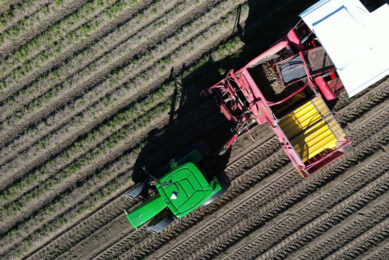Precision harvesting market to grow to USD 22.9 billion

Increasing adoption of autonomous combine harvesters and harvesting robots are driving the market growth.
The global precision harvesting market size was valued at USD 11.6 billion in 2019 and is expected to register a CAGR of 8.6% from 2020 to 2027, according to a new report by Grand View Research.
Autonomous combine harvesters and harvesting robots
According to the report, increasing adoption of autonomous combine harvesters and harvesting robots, increasing mechanisation of farms in developing economies of Africa and Asia Pacific regions, and increased labor cost due to shortfall of skilled labor are the significant factors driving the market growth.
Hardware held the largest market share owing to the high adoption of control and automation devices, such as guidance and steering systems, Global Positioning System (GPS), sensors, and yield monitors.
The report states that In the coming three decades, the world population is expected to increase by an additional 2.2 billion people. At the same time, water and land resources are decreasing due to pollution, land degradation, and urban encroachment. This entire scenario has fundamentally altered traditional methods of food production, forcing farmers to adopt precision harvesting techniques to produce more.
Text continues underneath image
Precision harvesting to transmute agriculture sector
The researchers state that precision harvesting is capable to transmute the agriculture sector and transform old-style harvesting activities into more economical and efficient ones. “The market is driven by increasing global food demand, minimising crop wastage during harvesting processes, and extended crop yield and profitability. Also, government initiatives in various countries are encouraging farmers to adopt advanced technological and agricultural machinery and tools to improve crop yield.”
Hardware to remain dominant
The report segments the precision harvesting market into hardware, software, and services. The hardware segment led the market for precision farming in terms of revenue in 2019 and is expected to remain dominant over the forecast period. The hardware segment has been further bifurcated into automation and control systems, sensing devices, and others.
The software segment is anticipated to register a CAGR of over 11% during the forecast period. Predictive analytics software is used to provide guidance to farmers about crop rotation, soil management, optimal planting times, and harvesting times.
Text continues underneath image
Increasing mechanisation in open field traditional farming
The crop harvesting segment held the largest market share in 2019 owing to increasing mechanisation in open field traditional farming, which includes crops such as sugarcane, corn, soybean, maize, cotton, wheat, and rice. Increasing adoption of autonomous precision harvesting equipment is one of the primary reasons for the segment growth.
The greenhouse harvesting segment is expected to register the highest CAGR over the forecast period. Changing climatic conditions, environmental problems, soil degradation, groundwater depletion, unavailability of farmworkers, and need for data analysis to improve farm productivity are leading to increased need for greenhouses. Greenhouses use robotics harvesting systems such as automatic conveyor and material handling, harvesting robotic arms, and spacing robots.
Text continues underneath image
North America
The North America regional market held the largest share in 2019 due to early adoption of precision harvesting technologies by countries like U.S. and Canada. The farmers in the North America region are adopting advanced equipment and harvesting systems such as sensors, steering and guidance systems, harvesting management software, and display devices.
Asia Pacific is expected to expand at the highest growth rate over the forecast period owing to increasing adoption of autonomous combine harvesters and harvesting robots, increasing farm mechanisation, and increasing labor costs due to the shortage of skilled workers.
Join 17,000+ subscribers
Subscribe to our newsletter to stay updated about all the need-to-know content in the agricultural sector, two times a week.



